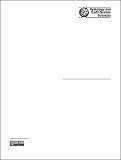Por favor, use este identificador para citar o enlazar a este item:
http://hdl.handle.net/10261/74221COMPARTIR / EXPORTAR:
 SHARE SHARE
 CORE
BASE CORE
BASE
|
|
| Visualizar otros formatos: MARC | Dublin Core | RDF | ORE | MODS | METS | DIDL | DATACITE | |

| Título: | Assessing the sources of uncertainty associated with the calculation of rainfall kinetic energy and erosivity - Application to the Upper Llobregat Basin, NE Spain |
Autor: | Catari Yujra, Gusman; Latron, Jérôme CSIC ORCID; Gallart Gallego, Francesc CSIC ORCID | Fecha de publicación: | 2011 | Editor: | European Geosciences Union Copernicus Publications |
Citación: | Hydrology and Earth System Sciences 15(3): 679-688 (2011) | Resumen: | The diverse sources of uncertainty associated with the calculation of rainfall kinetic energy and rainfall erosivity, calculated from precipitation data, were investigated at a range of temporal and spatial scales in a mountainous river basin (504 km2) in the south-eastern Pyrenees. The sources of uncertainty analysed included both methodological and local sources of uncertainty and were (i) tipping-bucket rainfall gauge instrumental errors, (ii) the efficiency of the customary equation used to derive rainfall kinetic energy from intensity, (iii) the efficiency of the regressions obtained between daily precipitation and rainfall erosivity, (iv) the temporal variability of annual rainfall erosivity values, and the spatial variability of (v) annual rainfall erosivity values and (vi) long-term erosivity values. The differentiation between systematic (accuracy) and random (precision) errors was taken into account in diverse steps of the analysis. The results showed that the uncertainty associated with the calculation of rainfall kinetic energy from rainfall intensity at the event and station scales was as high as 30%, because of insufficient information on rainfall drop size distribution. This methodological limitation must be taken into account for experimental or modelling purposes when rainfall kinetic energy is derived solely from rainfall intensity data. For longer temporal scales, the relevance of this source of uncertainty remained high if low variability in the types of rain was supposed. Temporal variability of precipitation at wider spatial scales was the main source of uncertainty when rainfall erosivity was calculated on an annual basis, whereas the uncertainty associated with long-term erosivity was rather low and less important than the uncertainty associated with other model factors such as those in the RUSLE, when operationally used for long-term soil erosion modelling. © 2011 Author(s). | Versión del editor: | http://dx.doi.org/10.5194/hess-15-679-2011 | URI: | http://hdl.handle.net/10261/74221 | DOI: | 10.5194/hess-15-679-2011 | Identificadores: | doi: 10.5194/hess-15-679-2011 issn: 1027-5606 e-issn: 1607-7938 |
| Aparece en las colecciones: | (IDAEA) Artículos |
Ficheros en este ítem:
| Fichero | Descripción | Tamaño | Formato | |
|---|---|---|---|---|
| assesing_sources_catari.pdf | 1,19 MB | Adobe PDF |  Visualizar/Abrir |
CORE Recommender
SCOPUSTM
Citations
19
checked on 16-abr-2024
WEB OF SCIENCETM
Citations
19
checked on 26-feb-2024
Page view(s)
309
checked on 23-abr-2024
Download(s)
206
checked on 23-abr-2024
Google ScholarTM
Check
Altmetric
Altmetric
NOTA: Los ítems de Digital.CSIC están protegidos por copyright, con todos los derechos reservados, a menos que se indique lo contrario.
